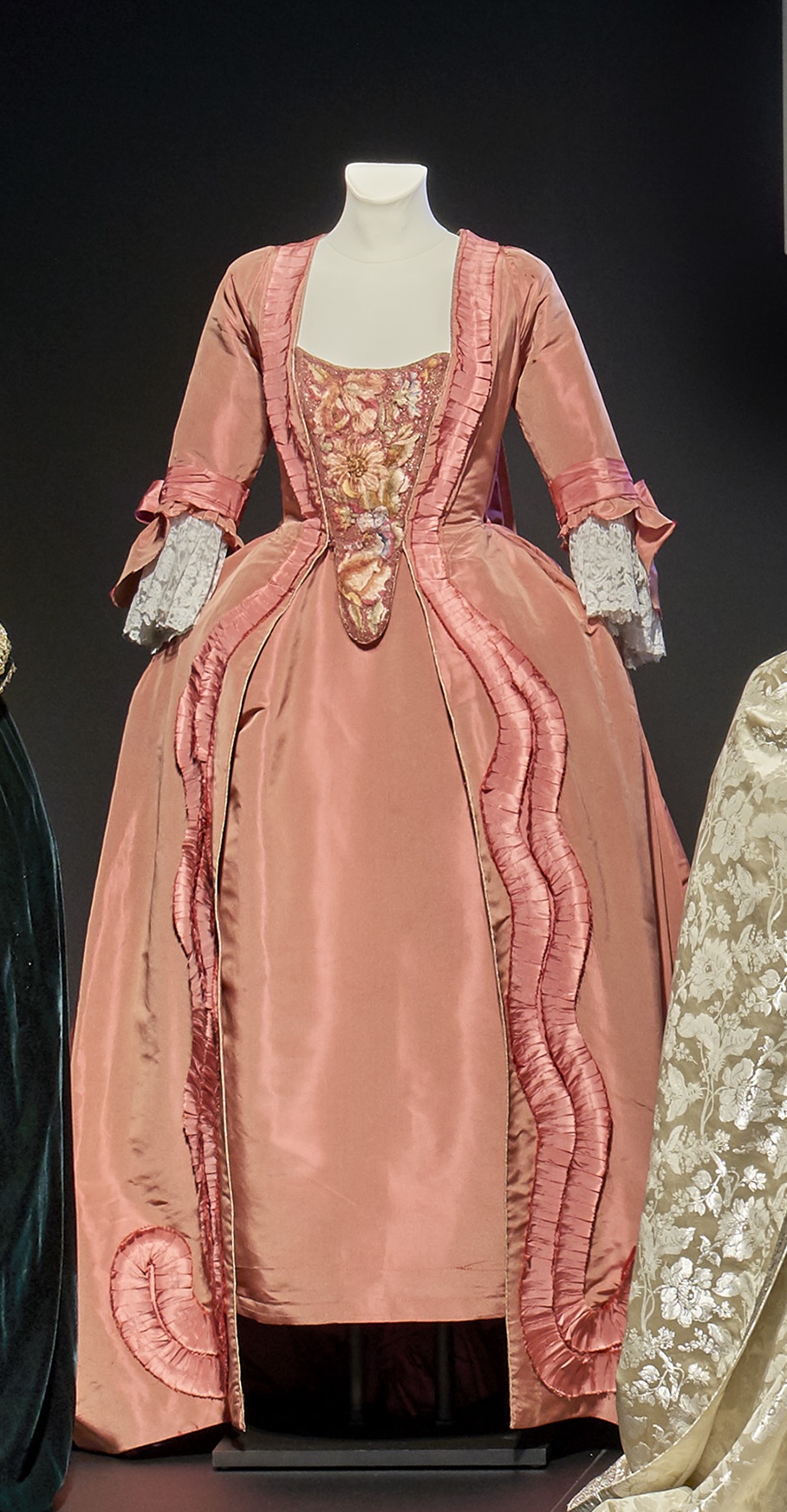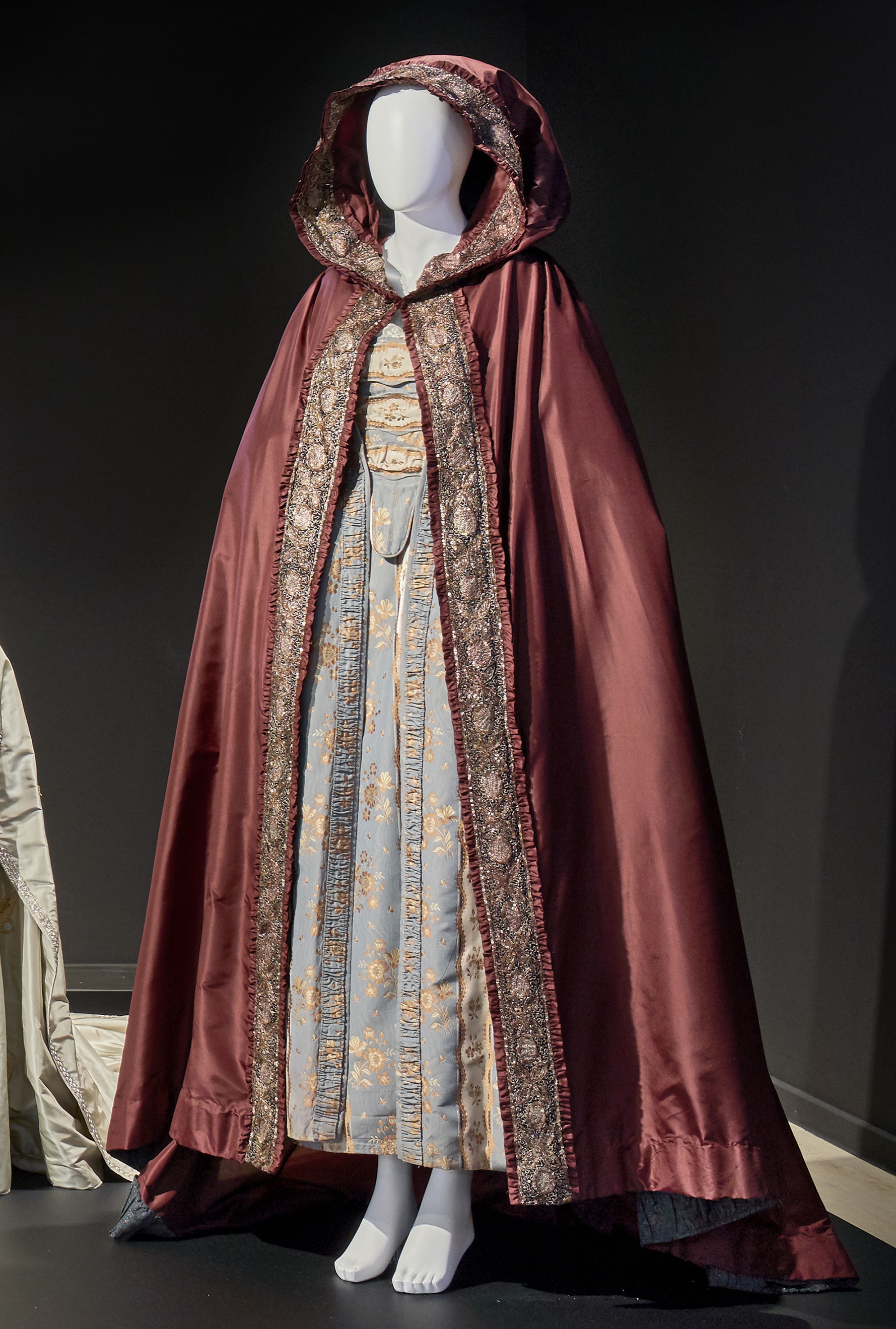
Blue velvet dress as worn by Jeanne Moreau in her role as Tsarina Elizabeth of Russia
Red three-piece silk dress as worn by Catherine Zeta-Jones in her role as Catherine
Catherine’s wedding dress
Catherine’s coronation dress
Day dress with cape as worn by Catherine Zeta-Jones in her role as Catherine
Stage 8: On display are five costumes from the movie Catherine the Great (Germany/USA 1994-96), directed by Marvin J. Chomsky and John Goldsmith.
The first costume on the left is:
a blue velvet dress
as worn by Jeanne Moreau in her role as Tsarina Elizabeth of Russia, the aunt of the future Tsar Peter III.
This regal outfit consists of a dark blue velvet mantua, skirt and stomacher. The term “mantua” refers to an 18th century open-fronted robe-like garment that drapes over the skirt and forms a train at the back. The front edges of the mantua are adorned with decorative gold trimming – which is delicate along the neckline then wider from the waist to the hem, with intertwining, thick gold braiding set against a dark green strip of moire satin ribbon with black stripes woven into it. The floor-length turquoise skirt features a jacquard pattern of dark-blue flowers. The skirt sits on a pannier, or side hoop, which extends the width of the skirt at the sides, leaving the front and back relatively flat and giving the impression of very wide hips. A triangle-shaped insert known as a stomacher fills the neckline, covering the bodice. The stomacher is decorated with gold embroidery, pearls and small gemstones that resemble diamonds. Along the edges of the neckline above the stomacher, white lace peeps out from underneath the mantua. The embroidery on the stomacher is repeated on the palm-wide cuffs witch are adorned with long lace flounces. In the film, Elizabeth accessorizes this gown with a short pearl and diamond necklace, drop earrings and several rings.
Made by and from the collection of Costumi d’Arte, Rome
To the right of this dress is:
a red three-piece silk dress
as worn by Catherine Zeta-Jones in her role as Catherine.
This ceremonial dress consists of a mantua, a bodice with a stomacher, and a skirt. The stomacher is embroidered with a dense floral pattern in gold, red and blue, overlaid with fine red-thread netting. The half-length sleeves are attached to the close-fitting bodice. Very wide-cut white lace flounces extend from the hem of the sleeve down to the wrist. At the hips, the skirt sits on a relatively narrow pannier. The edges of the mantua are decorated with two double-pleated ribbons of the same red fabric as the dress, one on top of the other. From the hips, these wide ribbons run in parallel wavy lines down to the hem, where they end in a semicircular loop. At the back of the dress, loose folds form at the shoulder blades creating the beginning of a wide, flowing train.
In the film, Catherine accessorizes the dress with a choker necklace and drop earrings with small diamonds. Her dark hair is pinned up and adorned with pink rose petals.
Made by and from the collection of The One, Rome
The third costume is:
Catherine’s wedding dress.
This is the dress worn by Catherine at her wedding ceremony with the Russian heir to the throne – the future Tsar Peter III. The floor-length dress is made of silver lamé brocade and features an interwoven floral pattern. The sweeping neckline hangs just off the shoulder and is edged with a wide lace flounce. The tapered, corset-like bodice laces up at the back. The stomacher is decorated with silver bullion embroidery – ornamental appliqués of delicate spirals. This pattern continues down the front of the inner skirt. Attached to the short sleeves are three lace flounces, which end at the elbow. The voluminous skirt cascades over a wide pannier at the hips. The overskirt is decorated with a silver border and extends into a very long train at the back.
In the film, Catherine accessorizes the dress with a large butterfly-shaped brooch worn just below the décolleté, hanging from which are three pendants of diamonds set in silver. She also wears earrings studded with two diamonds. Her dark hair is worn up and decorated with a white bow with hanging diamond chains.
Made by and from the collection of Costumi d’Arte, Rome
The fourth costume is:
Catherine’s coronation dress.
In the film, this is the dress worn by Catherine on the occasion of her coronation in 1762. The floor-length dress of metallic-gray silk with an overskirt is inspired by an 18th century mantua ensemble. The shimmering fabric features a repeated pattern of the Russian two-headed eagle embroidered in gold thread. The bird has its wings spread and holds the Russian imperial scepter in its right claw and the Russian imperial orb in its left. The neckline is framed by a wide lace flounce with a floral pattern, decorated with sequins and gemstones. The dramatically tapered corset-like bodice laces up at the back. Two of the gold two-headed eagles are embroidered one above the other on the bodice – the top one hidden under the flounce. Three layers of lace flounces adorns the half-length sleeves. The pleated skirt and the open-front overskirt both sit on an oval-shaped pannier at the hips. The overskirt is decorated at the edges with a narrow, silver brocade border and extends into an oversized train at the back. In the film, Catherine wears a large round crown or a flat diadem with this dress. She accessorizes with large diamond earrings and a choker necklace. The long, weighty coronation chain of large round diamonds rests upon her shoulders.
Made by and from the collection of Costumi d’Arte, Rome
The last of Catherine’s costumes displayed on this stage is:
a day dress with cape.
This three-piece light-blue day dress made of cotton damask has cream-colored vertical stripes and a woven pattern of golden-yellow and golden-brown flowers and vines. It consists of a mantua, stomacher and skirt. The edges of mantua feature a decorative pleated border in the same fabric. The mantua has a deep, square neckline, below which is the decorative stomacher. In the film, the stomacher that goes with this day dress is embroidered with leaf and vine motifs in blue and gold; the stomacher in the exhibition features light blue and cream-colored horizontal stripes. The loosely falling sleeves have wide cuffs with lace flounces that start just below the elbow. The floor-length skirt sits on an oval pannier at the hips and the mantua forms a short train at the back. During the alms offering, Catherine wears a burgundy silk cape with a large hood and long train over the dress. A decorative border runs along the edge of the hood and down both sides of the cape’s opening to the hem. This border is roughly a hand’s width and features flower and vine embroidered motifs in gold and silver. Ruched fabric runs down both sides of the border.
Made by and from the collection of The One, Rome






